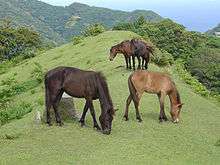Misaki horse
The Misaki (御崎馬/岬馬, Misaki uma) is a critically-endangered Japanese breed of small horse. It is one of eight Japanese native horse breeds, and lives as a feral horse in a natural setting in a designated National Monument on Cape Toi (also known as Toimisaki) within the municipal boundaries of Kushima at the south end of Miyazaki Prefecture on the island of Kyūshū. The Misaki was made a Japanese National Natural Treasure in 1953.[2]:16
 | |
| Conservation status | FAO (2007): critically endangered[1]:71 |
|---|---|
| Other names | |
| Country of origin | Japan |
| Distribution | Cape Toi, Miyazaki Prefecture |
| Traits | |
| Height |
|
| Colour | dark colours |
History
Japanese horses are thought to derive from stock brought at several different times from various parts of the Asian mainland; the first such importations took place by the sixth century at the latest.[3] Horses were used for farming – as pack-animals although not for draught power; until the advent of firearms in the later sixteenth century, they were much used for warfare.[4]:67 The horses were not large: remains of some 130 horses have been excavated from battlefields dating to the Kamakura period (1185–1333 AD); they ranged from 110 to 140 cm in withers height.[4]:67
The breed was first identified in the historical record in 1697 when the Akizuki family of the Takanabe Clan rounded up feral horses and developed a pool of breeding stock.
The Misaki and the area in which it lives, Cape Toi, were declared a Natural Monument in 1953 (Shōwa 28).[5]. The horses are a popular draw for tourists in the region.
In 2007, the Misaki was classified as "critical-maintained" by the FAO.[1]:71 The population is approximately 120,[6][7]:486 up from a low of 53 individuals recorded in 1973.[4]:94
A genetic study of Japanese and Mongolian horse breeds in 2003 found the Misaki to be most closely related to the Noma, Tokara and Yonaguni breeds.[8]:379 In 2011, twelve horses of the Misaki herd gave positive Coggins test results for equine infectious anaemia. From the blood of one of them, the whole viral genome was sequenced. It was found to be substantially different from the two equine infectious anaemia strains that had previously been completely sequenced.[9]:363
Characteristics
The Misaki is a small dark-coloured horse, standing about 132 cm at the withers.[6][7]:486
References
- Barbara Rischkowsky, D. Pilling (eds.) (2007). List of breeds documented in the Global Databank for Animal Genetic Resources, annex to The State of the World's Animal Genetic Resources for Food and Agriculture. Rome: Food and Agriculture Organization of the United Nations. ISBN 9789251057629. Accessed July 2017.
- Taro Obata, Hisato Takeda, Takao Oishi (1994). Japanese native livestock breeds. Animal Genetic Resources Information 13: 11-22.
- Japanese Native Horses. International Museum of the Horse. Archived 22 August 2010.
- [Editorial Committee Office of the Japanese Country Report, Animal Genetic Resources Laboratory, National Institute of Agrobiological Sciences, Japan] ([n.d.]). Country Report (For FAO State of the World’s Animal Genetic Resources Process); annex to: Barbara Rischkowsky, D. Pilling (editors) (2007). The State of the World's Animal Genetic Resources for Food and Agriculture. Rome: Food and Agriculture Organization of the United Nations. ISBN 9789251057629. Accessed July 2017.
- 岬馬およびその繁殖地 (in Japanese). 国指定文化財等データベース. The Agency for Cultural Affairs. Accessed July 2017.
- Breed data sheet: Misaki/Japan. Domestic Animal Diversity Information System of the Food and Agriculture Organization of the United Nations. Accessed July 2017.
- Valerie Porter, Lawrence Alderson, Stephen J.G. Hall, D. Phillip Sponenberg (2016). Mason's World Encyclopedia of Livestock Breeds and Breeding (sixth edition). Wallingford: CABI. ISBN 9781780647944.
- T. Tozaki, N. Takezaki, T. Hasegawa, N. Ishida, M. Kurosawa, M. Tomita, N. Saitou, H. Mukoyama (2003). Microsatellite Variation in Japanese and Asian Horses and Their Phylogenetic Relationship Using a European Horse Outgroup. Journal of Heredity 94 (5): 374–380. doi:10.1093/jhered/esg079. (subscription required).
- Jian-Bao Dong, Wei Zhu, Frank R. Cook, Yoshitaka Goto, Yoichiro Horii, Takeshi Haga (2013). Identification of a novel equine infectious anemia virus field strain isolated from feral horses in southern Japan. Journal of General Virology 94: 360–365. doi:10.1099/vir.0.047498-0.